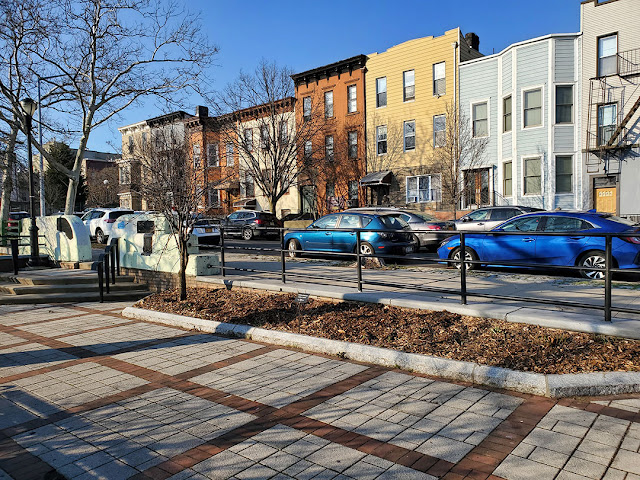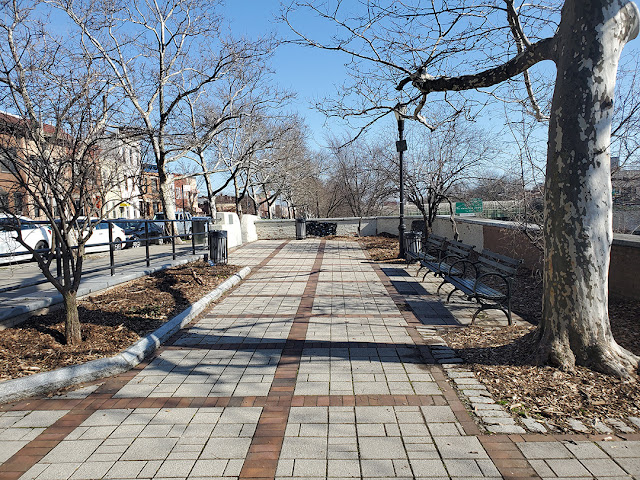I feel like a cat who has just covered up a smelly thing in their litterbox and has dusted off their paws and wants nothing more to do with it. What, that? That wasn't me?!
But here goes.
Two Wednesdays ago I ignored all the things I should have been doing and went to my friend Hannah's house in Park Slope to dig up plants. She was moving, packing up, and going on a big adventure, and had invited me to take anything in her garden (above) that might appeal to me. I was thrilled, and told her about the park on 18th Street and the plants it needed, and she said I was welcome to them. (For the backstory, visit these links for the #18thStreetPollinator garden, Parts One and Two.)
If only I could undo it.
Hannah lent me her garden clogs. It was muddy. I dug while a cardinal sang.
Very little had emerged, yet, but investigative digging revealed three intriguing mystery plants from a Brooklyn Botanic Garden sale. They had succulent white roots and were making lipstick-pink shoots. I found and dug up the dormant rootstocks of Japanese anemones and astilbe, which were carefully arranged in milk crates that Hannah gave me. The hostas of summer could not be located in mid-March. One crate was devoted to ferns. As I worked a procession of people from a Buy Nothing group perused some stellar free stuff in the apartment.
As nearby church bells rang noon I pruned back unruly raspberry canes and dug them up with chunks of earth attached to their roots. A loose-limbed and very prickly rambling rose followed. Hannah said its flowers were white. I imagined them in bloom in early summer, and raspberries making fruit for visitors to the park.
Along with plants donated by the Gowanus Nursery and by Alyse, a neighbor and Instagram friend, this collection would actually create a sense of structure for the plantless park around the corner from where we live. Flowers for pollinators and people.
When everything was ready I fetched and double-parked the car Brooklyn-style, loaded up, and drove the plants to 18th Street. (Sorry about the plastic trash bags, but that rose really was very prickly.)
At the park I planted the liatris, iris, and lily bulbs that I bought a few days before. I tried not to disturb the alliums that had set the whole thing in motion, and which had already rooted. I placed, and planted, the rest. (My tools were a newly-acquired Fiskars spade and trowel; my terrace-gardening is minimalist: just a fierce Japanese hori, essentially useless in the deep, wood chip mulch, here.)
The next day, around Thursday, noon, I walked by to see how it was all doing in the promised rain.
I noticed some black trash bags on the sidewalk. Then I saw an unusually deep depression where some of the liatris bulbs had been planted. Something was missing.
Everything.
But the #18thStreetPollinators sign was still there.
I felt hollow. I looked at the row of houses facing the park. What had they seen?
At home I refunded the three kind people who had donated money (the Donate button had only gone live the day before).
The next day I wrote to the plant donors. It was the only time I cried. And since then I have tried not to think about it at all.
So what happened?
Either: Someone had been watching. And moved in immediately. Or: The NYC Parks Department came by - either scheduled or due to a complaint - and the workers removed every well-considered plant. This is the most likely scenario. (Except...the bulbs?)
I knew I was guerilla gardening, and I knew it was a risk. That was why I had the sign made. So anyone could go online with the hashtag to find out more. Fingers crossed. Stupid fingers.
So what now?
It's simple. I quit. Whoever did it, whether through the vandalism of indifference, or through malice, or greed, won.
Trying to define what flattened me, it is a combination of the destroyed potential, and quite simply, the plants. Just ripped out. I am at a loss.
I know why I did this: to make a beautiful space in a barren piece of land - a wasted, precious park. And, as Russia was invading Ukraine, this seemed a positive thing and a way to channel my own sense of helplessness. But I feel very stupid, and so very bad for the givers of plants.
As an epitaph, here is what was planted. Possibly some of the bulbs made it.
Gowanus Nursery:





















